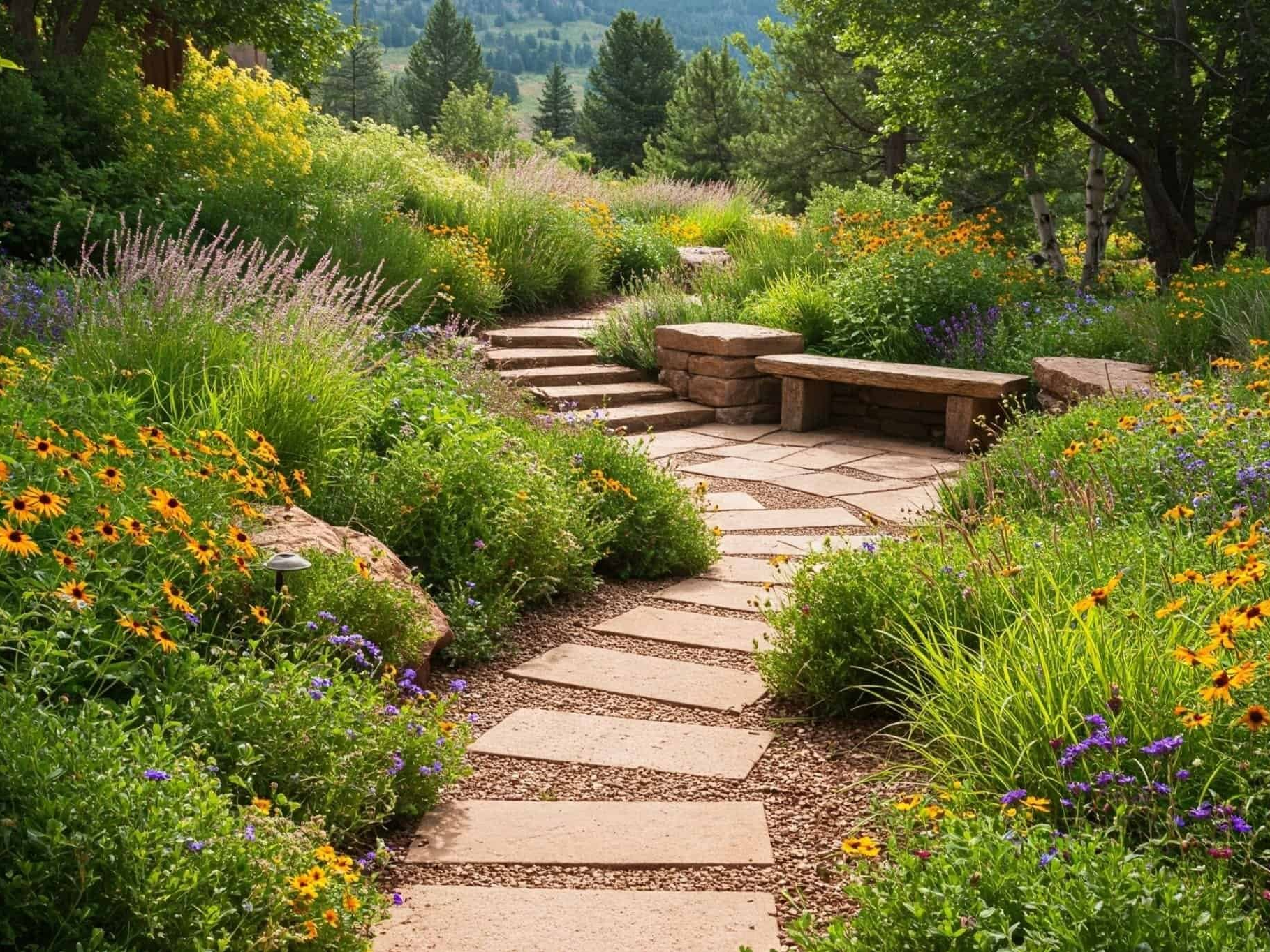
Outdoor Spaces Reimagined
We replace traditional lawns with sustainable, water-smart landscapes that meet local mandates and increase property value.
As water restrictions tighten, traditional lawns are becoming harder to maintain. At TerraFora, we design beautiful, low-maintenance landscapes using native plants and xeriscaping principles that thrive in Colorado’s dry climate: sustainable, water-wise, and built to last.
Built for Colorado
We understand the soil, the sun, and the seasons. Your landscape is designed to succeed in this climate year after year.Rebate-Qualified Installs
Our projects meet the standards required by local turf replacement programs so you can access available savings.Sustainable and Local
We use native plants and locally sourced materials whenever possible. This supports Colorado growers and keeps your landscape rooted in the region.Complete Service
We handle everything from design and turf removal to planting and installation. You get clear communication and reliable results at every step.
Sustainable Solutions for Colorado’s Turf Replacement Mandates
1. Full Turf Removal to Meet Water-Use Mandates
Many counties and cities across Colorado are now requiring the replacement of high-water-use turf. At TerraFora, we start every project with full turf removal and design for long-term sustainability. We focus on smart plant placement, soil health, and efficient irrigation to build native landscapes that thrive in dry conditions and support the region’s broader water conservation goals.
2. Designs Aligned with Regional Water Mandates
Each Terrafora landscape is carefully planned to meet evolving local water-use standards and sustainability goals. From plant selection to irrigation layout, every detail is chosen to support long-term water efficiency, ecological resilience, and compliance with municipal requirements.
3. Native and Drought-Tolerant Plants First
Every Terrafora landscape is built around native and climate-adapted plants chosen specifically for Colorado’s Front Range and Southern Rockies. These low-water species are selected for their long-term resilience, natural beauty, and ability to thrive in dry conditions, while supporting local ecology and reducing the need for ongoing maintenance.
A Smarter Landscape for Colorado
Watering, mowing, and fertilizing a traditional lawn in this climate wastes time, money, and resources. Xeriscaping offers a better way. It replaces constant upkeep with a landscape that looks great, uses less water, and works with the land instead of against it.
The Benefits of Xeriscaping
Lower Your Water Bill
Use up to 75% less water compared to a conventional lawn.
Spend Less Time on Yard Work
Enjoy your outdoor space without the constant upkeep.
Improve Curb Appeal
A well-designed xeriscape adds beauty and long-term value to your home.
Support Native Habitat
Drought-tolerant plants create space for pollinators and other beneficial wildlife.
Skip the Chemicals
Healthy soil and native plants reduce the need for fertilizers and pesticides.
Fewer Weeds and Pests
Well-adapted plants are more resistant to common yard problems.
Understanding Your Soil for a Thriving Xeriscape
At Terrafora, we believe in working with nature. Our plant selections are specifically chosen to thrive in Colorado's native soil conditions, minimizing the need for extensive amendments. While our kits don't include soil amendments, we strongly encourage you to evaluate your soil's suitability for the plants you choose.
Our philosophy emphasizes sustainable practices and supporting natural ecosystems with minimal disruption. Any adjustments you make should align with xeriscaping principles of water conservation and sustainable landscaping.
Clay Soil
Clay soil is dense, sticky, and retains moisture for a long time. While it holds nutrients well, it often drains poorly, which can lead to waterlogged roots if not carefully managed.
Best for: Moisture-loving plants, shrubs, and trees that tolerate wet conditions.
Considerations: Focus on plants with deep roots to help stabilize the soil and improve drainage.
How to test: Take a small handful of damp soil and try rolling it into a ball. If it forms a smooth, sticky ball that holds its shape, it's likely clay.
Sandy Soil
Sandy soil is loose and drains quickly, struggling to retain moisture and nutrients. It's prone to drying out fast.
Best for: Drought-tolerant plants, grasses, and succulents that don’t require frequent watering.
Considerations: Choose plants adapted to quick drainage. Occasional watering may still be needed in very dry periods.
How to test: Take a small handful of damp soil and squeeze it. If it crumbles easily and doesn’t hold together, it’s likely sandy.
Loamy Soil
Loam is the ideal soil type, offering a perfect balance of clay, sand, and silt. It boasts excellent drainage while retaining just the right amount of moisture and nutrients, making it suitable for most plants.
Best for: A wide variety of plants, including perennials, grasses, shrubs, and flowers.
Considerations: Loam generally requires less maintenance, though occasional amendments might be beneficial to keep it in top condition.
How to test: Take a small handful of damp soil and squeeze it. If the soil holds its shape but crumbles easily. you likely have loam soil.
-
Terrafora completely changed our yard. Our water bill dropped by more than half, and the native plants attract so much wildlife. We love spending time outside now.
— Megan L., Colorado Springs
-
The team handled everything from design to installation. Our new landscape looks amazing and is so easy to maintain.
— Tom R., Monument
-
I was worried about how my yard would look without grass. TerraFora created a beautiful outdoor space that fits perfectly with Colorado’s climate and saves water every season.
— David S., Castle Rock
Ready to Transform Your Outdoor Space?
Have questions? We’re here to help. If you’re thinking about replacing your lawn with a low-water landscape, we’ll walk you through the process, answer your questions, and help you understand what to expect. From the first conversation to the final install, you’ll have clear guidance and local expertise every step of the way.






